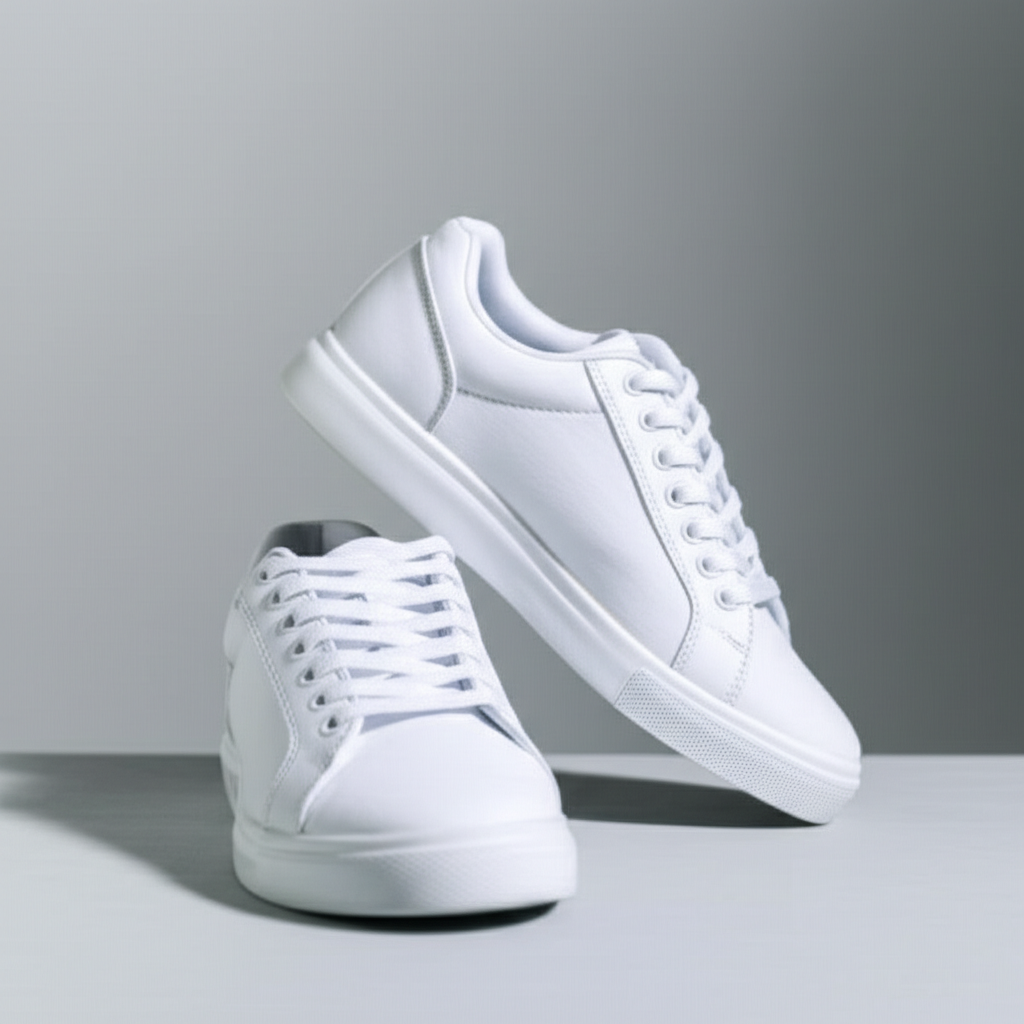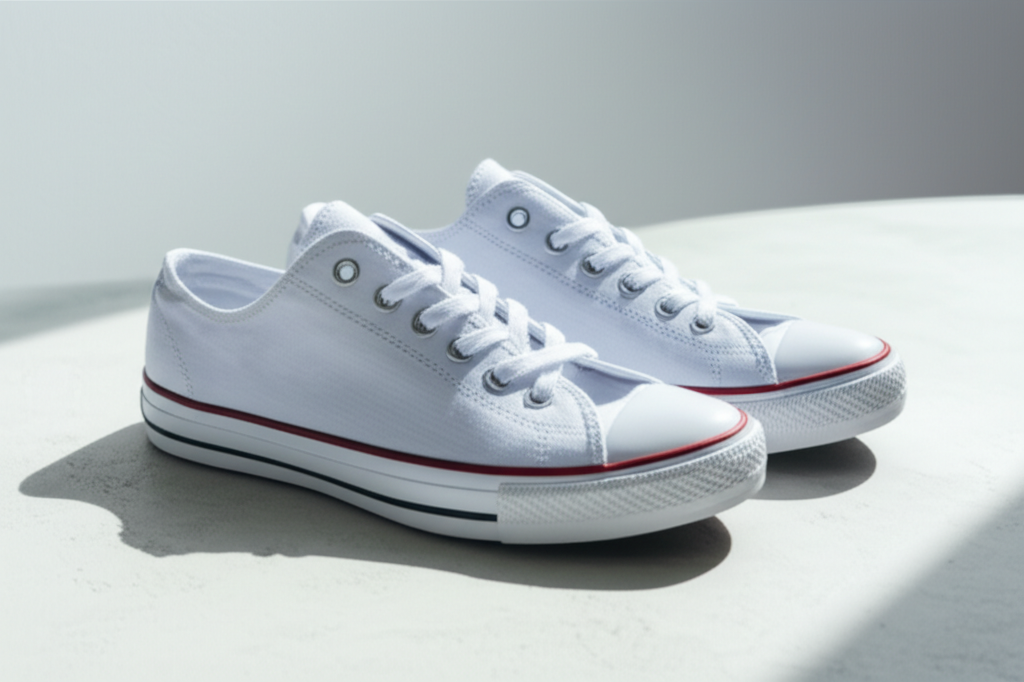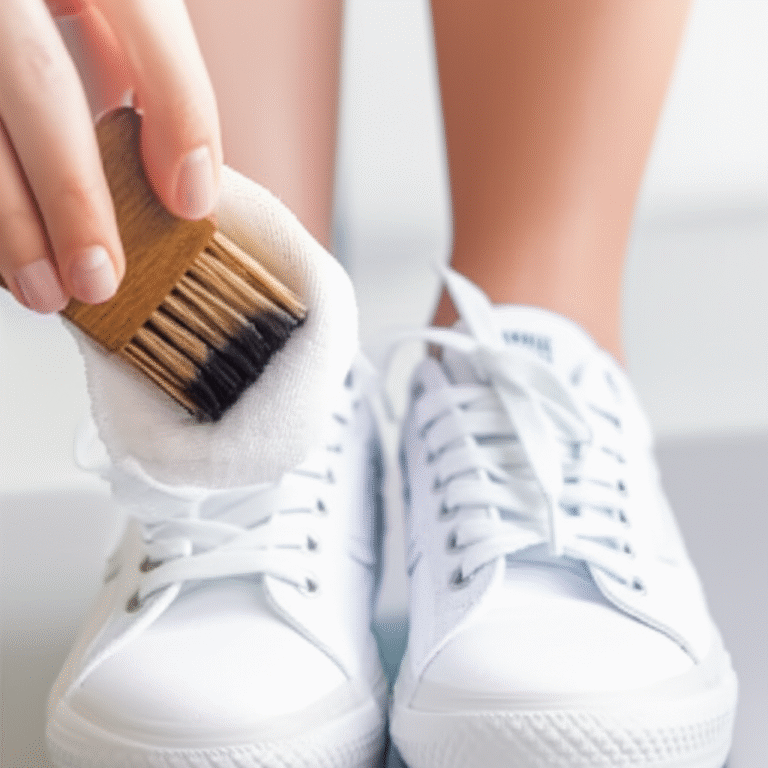The best way to clean white shoes involves a gentle yet effective approach, often using a combination of mild soap, water, and a soft brush or cloth, tailored to the shoe’s material. Regular spot cleaning and preventative measures are key to keeping them looking their best.
Key Takeaways
- Spot clean regularly to prevent stains setting in.
- Choose cleaning methods based on shoe material (leather, canvas, mesh).
- Mild soap and water are your go-to for most white shoes.
- Use specialized cleaners for tough stains or delicate materials.
- Protect white shoes with sprays to repel dirt and water.
- Air dry all white shoes; avoid direct heat.
What is the Best Way to Clean White Shoes?
White shoes are a fashion staple, looking sharp with almost any outfit. But keeping them pristine can feel like a constant battle. Stains, scuffs, and general dinginess can quickly dull their shine, leaving you wondering if they’re even worth the effort. Many people find cleaning white shoes confusing, unsure of what products to use or how to avoid damaging them. But don’t worry! With the right knowledge and a few simple steps, you can easily restore your white shoes to their former glory. This guide will walk you through the best ways to clean white shoes, no matter the material, so you can confidently step out in style.
Understanding Your White Shoes: Material Matters

Before you grab any old cleaning spray, it’s crucial to identify what your white shoes are made of. Different materials require different care. Using the wrong method can lead to discoloration, damage, or even ruin your favorite pair. Let’s break down the most common materials:
Canvas and Fabric Shoes
Canvas shoes, like many popular sneakers, are generally durable and can withstand a good scrub. The fabric weave, however, can absorb stains more easily than smoother materials. For these, a gentle detergent and water solution is often the most effective.
Leather and Synthetic Leather Shoes
Leather and its synthetic counterparts are smoother and less absorbent, making them somewhat easier to wipe clean. However, they can be prone to scuff marks and require specific cleaners to maintain their finish and prevent cracking or drying out. Harsh chemicals can strip the natural oils from leather, leading to damage.
Mesh and Knit Shoes
Modern athletic shoes often feature mesh or knit uppers. These materials are breathable and lightweight but can be delicate. They can snag easily and are prone to stretching if scrubbed too aggressively. A very soft brush or cloth and a mild cleaning solution are essential here.
Suede and Nubuck Shoes
These materials are the trickiest. Suede and nubuck have a soft, fuzzy texture that is highly susceptible to water stains and dirt. Special brushes and cleaning products designed specifically for suede are a must. Water is often the enemy of these materials, so approach with caution.
Gathering Your Essential White Shoe Cleaning Supplies
Having the right tools on hand makes the cleaning process much smoother. You don’t need a huge arsenal; a few basic items will serve you well for most situations. Here’s a list of helpful supplies:
- Soft Bristle Brush: An old toothbrush or a dedicated shoe brush works wonders for scrubbing away dirt without damaging the material.
- Microfiber Cloths: These are excellent for wiping down surfaces, applying cleaners, and buffing. Have a few handy – one for cleaning, one for rinsing, and one for drying.
- Mild Dish Soap or Laundry Detergent: For most general cleaning, a few drops of gentle soap mixed with water is perfect. Avoid harsh detergents that can bleach or damage.
- Baking Soda: A fantastic natural cleaner and whitener, especially for canvas and rubber soles.
- White Vinegar: Useful for tackling tough stains and deodorizing, but use sparingly and dilute it.
- Magic Eraser (Melamine Foam): Excellent for scuffs on rubber midsoles and sometimes on smooth leather.
- Specialized Shoe Cleaner: For specific materials like leather or suede, a dedicated cleaner is often the safest and most effective option.
- Protective Spray: Once clean, a water and stain repellent spray can help keep your shoes looking good for longer.
- Shoe Trees or Stuffing: To help shoes maintain their shape while drying.
For more stubborn issues, you might consider a DIY paste of baking soda and water, or a specialized shoe cleaner kit. It’s always a good idea to test any cleaning solution on an inconspicuous area first.
The Best Way to Clean White Canvas and Fabric Shoes

Canvas shoes are popular for a reason – they’re comfortable and versatile. Cleaning them is usually straightforward. The key is to work gently to avoid pushing dirt deeper into the fabric.
Step-by-Step Cleaning for Canvas
- Remove Laces and Insoles: Take out the shoelaces and insoles. You can usually wash laces in a mesh bag with your laundry. Insoles can often be wiped down separately.
- Brush Off Loose Dirt: Use a dry, soft brush to remove any surface dirt, dust, or debris. Get into the crevices and around the stitching.
- Prepare Your Cleaning Solution: Mix a small amount of mild dish soap or laundry detergent with warm water in a bowl. For extra whitening power, you can add a tablespoon of baking soda to create a paste.
- Scrub Gently: Dip your brush into the cleaning solution. Gently scrub the canvas in a circular motion, paying extra attention to stained areas. Don’t oversaturate the shoe.
- Rinse Thoroughly: Wipe away the soap residue with a clean, damp cloth. You might need to rinse the cloth and wipe multiple times to ensure all soap is gone.
- Tackle Tough Stains: For stubborn spots, apply a bit of the baking soda paste directly to the stain and let it sit for a few minutes before gently scrubbing.
- Clean the Soles: Use an old toothbrush dipped in the cleaning solution or a Magic Eraser to scrub the rubber soles and midsoles.
- Air Dry: Stuff the shoes with paper towels or shoe trees to absorb moisture and help them keep their shape. Let them air dry completely away from direct sunlight or heat, which can cause yellowing or material damage.
Pro Tip:
For yellowing on white canvas, a paste made from baking soda and hydrogen peroxide can sometimes work wonders. Apply it, let it sit in the sun for a few hours (if safe for the material), then rinse and air dry.
How to Clean White Leather and Synthetic Leather Shoes
Leather shoes, whether genuine or synthetic, require a slightly different approach to maintain their smooth finish and prevent damage. Harsh scrubbing or soaking can be detrimental.
Step-by-Step Cleaning for Leather
- Remove Laces: As with canvas shoes, start by removing the laces.
- Wipe Down: Use a dry, soft cloth to wipe away any loose dust or dirt.
- Use a Leather Cleaner: Apply a small amount of a reputable leather cleaner onto a clean cloth. Gently wipe down the entire surface of the shoe. Work in sections.
- Address Scuffs and Marks: For minor scuffs on smooth leather, a Magic Eraser can be very effective. Lightly rub the scuff mark. Be gentle to avoid removing the shoe’s finish.
- Clean Soles: Use a separate cloth or an old toothbrush with a bit of leather cleaner or mild soap and water to clean the rubber soles.
- Wipe Off Residue: Use a clean, slightly damp cloth to wipe away any cleaner residue.
- Condition (for Genuine Leather): After cleaning and once dry, apply a small amount of leather conditioner to moisturize and protect the leather. This prevents cracking.
- Air Dry: Allow the shoes to air dry completely. Avoid any heat sources.
For synthetic leather, you can often use a mild soap and water solution if a dedicated cleaner isn’t available, but always test on a small area first. The key is to avoid soaking the material.
Cleaning White Mesh and Knit Sneakers
Mesh and knit materials are popular for their breathability and comfort, but they can be delicate. Aggressive cleaning can cause tears or stretching.
Step-by-Step Cleaning for Mesh/Knit
- Remove Laces and Insoles: Take these out to clean them separately.
- Brush Off Debris: Gently brush away any loose dirt or debris with a very soft brush or a dry cloth.
- Prepare Mild Solution: Mix a small amount of mild detergent (like Woolite) or dish soap with cool water. Avoid hot water, which can damage synthetics.
- Spot Clean: Dip a soft cloth or sponge into the solution. Gently dab and wipe the mesh or knit surface. For tougher spots, use a very soft toothbrush with minimal pressure.
- Rinse Carefully: Use a clean cloth dampened with plain water to wipe away the soap. Be careful not to oversaturate the material.
- Clean Midsoles: A toothbrush and mild soap solution or a Magic Eraser can be used on the rubber parts.
- Air Dry: Stuff the shoes with white paper towels (colored ones can bleed ink) or shoe trees. Let them air dry completely, away from heat and direct sun.
Never put mesh or knit shoes in a washing machine unless the manufacturer explicitly states it’s safe. The tumbling action can easily damage these delicate materials.
Special Care for White Suede and Nubuck Shoes
Suede and nubuck are beautiful but notoriously difficult to keep clean. Water is their biggest enemy, often causing permanent stains and stiffening the material. You’ll need specialized tools for these.
Step-by-Step Cleaning for Suede/Nubuck
- Ensure Shoes are Dry: Never try to clean wet suede or nubuck. Let them dry completely first.
- Brush Away Dry Dirt: Use a dedicated suede brush or a clean, dry toothbrush to gently brush away loose dirt and dust. Always brush in the same direction.
- Use a Suede Eraser: For scuffs and marks, use a suede eraser. Rub gently over the affected area.
- Tackle Stains (Carefully): For tougher stains, a specialized suede cleaner is your best bet. Follow the product instructions precisely. Often, these involve applying a foam or liquid cleaner and then brushing.
- Water Stains: If you get a water stain, try dampening the entire shoe lightly with a fine mist of water and then brushing it while damp to help it dry more evenly. This is a risky technique and should be a last resort.
- Restore Nap: After cleaning and drying, use the suede brush to gently restore the fuzzy texture (the nap).
- Protect: Once clean and completely dry, apply a suede protector spray. This is crucial for preventing future stains.
Avoid using water-based cleaners or regular soap on suede and nubuck. Always test any product on an inconspicuous spot first.
Cleaning White Shoe Soles and Midsoles
The rubber soles and midsoles of your white shoes often take the brunt of the dirt and scuffs. Keeping them clean can make a huge difference in the overall appearance of your shoes.
Effective Methods for White Soles
- Mild Soap and Water: For everyday dirt, a soft brush or cloth with warm, soapy water is usually sufficient.
- Baking Soda Paste: Mix baking soda with a little water to form a paste. Apply it to the soles, let it sit for a few minutes, then scrub with a brush. Rinse well.
- Magic Eraser: This is a powerhouse for scuffs and ingrained dirt on rubber. Wet the eraser slightly and gently rub the soles.
- Toothpaste (Non-Gel White): Apply a small amount of white, non-gel toothpaste to a toothbrush and scrub the soles. Wipe clean with a damp cloth.
- Specialized Sole Cleaners: You can find cleaners specifically designed for shoe soles and midsoles, which can be very effective for tougher grime.
Remember to protect the upper part of your shoe when cleaning the soles, especially if using a stronger cleaner or a Magic Eraser, as these can sometimes affect delicate materials.
DIY vs. Commercial Shoe Cleaners: What’s Best?
When it comes to cleaning white shoes, you have options. Both DIY methods and commercial cleaners have their pros and cons.
| Method | Pros | Cons | Best For |
|---|---|---|---|
| DIY (Soap/Water, Baking Soda) | Affordable, readily available ingredients, generally gentle. | May not be effective on very tough stains, requires some mixing. | General dirt, light stains on canvas, fabric, and some leather. |
| Commercial Shoe Cleaners | Formulated for specific materials, often more effective on tough stains, convenient. | Can be more expensive, need to buy specific products for different shoe types. | All shoe types, especially for specialized care of leather, suede, or performance fabrics. |
For everyday cleaning and light dirt, DIY solutions are often perfectly adequate and cost-effective. However, for stubborn stains, delicate materials like suede, or expensive sneakers, investing in a good quality commercial shoe cleaner and protector can be a wise decision. Always read product labels carefully to ensure compatibility with your shoe material.
A good example of a reputable resource for shoe care products and advice is the Smithsonian Magazine article on shoe cleaning, which often delves into the science behind different cleaning agents and materials.
Preventative Measures: Keeping White Shoes White
The best way to deal with dirty white shoes is to prevent them from getting dirty in the first place. A little preventative care goes a long way.
- Apply a Protective Spray: After cleaning and drying, treat your white shoes with a water and stain repellent spray. Look for sprays designed for the specific material of your shoes (e.g., canvas protector, leather protectant, suede protector). Reapply periodically, especially after heavy wear or cleaning.
- Wipe Down After Wear: Make it a habit to quickly wipe down your shoes with a damp cloth after each wear. This removes surface dirt before it has a chance to set in.
- Avoid Bad Weather: If possible, avoid wearing your pristine white shoes in heavy rain, mud, or dusty conditions.
- Store Properly: When not in use, store your white shoes in a cool, dry place. Keep them away from direct sunlight, which can cause yellowing. Using shoe trees or stuffing them with paper can help maintain their shape and absorb any residual moisture.
These simple steps can significantly extend the life and maintain the fresh look of your white footwear.
Drying Your White Shoes Correctly
Drying is a critical step that many people overlook. Improper drying can lead to yellowing, material damage, or even mold growth.
- Always Air Dry: Never put your white shoes in a clothes dryer or use a hairdryer on high heat. High temperatures can warp the shape, melt adhesives, damage synthetic materials, and cause yellowing.
- Stuff Them: Fill the shoes with white paper towels, newspaper (be cautious of ink transfer), or shoe trees. This helps them retain their shape and absorbs moisture from the inside.
- Find a Good Spot: Place the shoes in a well-ventilated area, away from direct sunlight or heat sources.
- Be Patient: Depending on the material and how wet they got, drying can take 12-24 hours or even longer. Ensure they are completely dry before wearing them again.
Frequently Asked Questions About Cleaning White Shoes
Q1: Can I put my white sneakers in the washing machine?
Generally, it’s best to avoid the washing machine for most white sneakers, especially those with leather, suede, or delicate mesh. The agitation can damage materials, cause yellowing, and affect the shoe’s structure. Handwashing with mild soap and water is almost always a safer and more effective method.
Q2: How do I get rid of yellow stains on my white shoes?
Yellowing can be caused by oxidation, detergent residue, or UV exposure. Try a paste of baking soda and water, or baking soda with a bit of hydrogen peroxide (test first!). Apply, let sit, gently scrub, and rinse thoroughly. For rubber soles, a Magic Eraser can also help. Ensure you rinse all cleaning agents completely.
Q3: What’s the best way to clean white shoe laces?
White shoe laces can usually be washed with your regular laundry. Place them in a mesh laundry bag to prevent them from getting tangled. For heavily stained laces, you can soak them in a mixture of warm water and a tablespoon of baking soda or a mild bleach solution (use cautiously and rinse well) before washing.
Q4: How often should I clean my white shoes?
It depends on how often you wear them and in what conditions. For daily wear, a quick wipe-down after each use is ideal. Deep cleaning should be done as needed, perhaps every few weeks or when you notice significant dirt or staining. Regular maintenance prevents deep-set stains.
Q5: Can I use bleach to clean white shoes?
Bleach can be effective for whitening, but it’s a harsh chemical. Use it very sparingly and diluted with water, and only on appropriate materials like plain white canvas or rubber. Test in an inconspicuous area first, as it can sometimes cause yellowing or damage delicate fabrics. Rinse extremely thoroughly.
Q6: My white leather shoes have scuff marks. How can I remove them?
For light scuffs on smooth leather, a Magic Eraser is often very effective. Gently rub the scuff mark. Alternatively, a small amount of non-gel white toothpaste on a soft cloth can also work. For deeper scuffs or damage, you might need a leather repair kit or professional help.
Conclusion
Keeping your white shoes looking their best doesn’t have to be a chore. By understanding the materials of your shoes and using the right cleaning techniques, you can effectively tackle dirt, stains, and scuffs. Remember to always start with the gentlest method and escalate if necessary. Regular maintenance, from a quick wipe-down after wear to applying protective sprays, is your secret weapon against the inevitable grime. With these tips and a little patience, your white shoes can stay bright and stylish for seasons to come, proving that the best way to clean white shoes is a combination of informed care and consistent effort.

